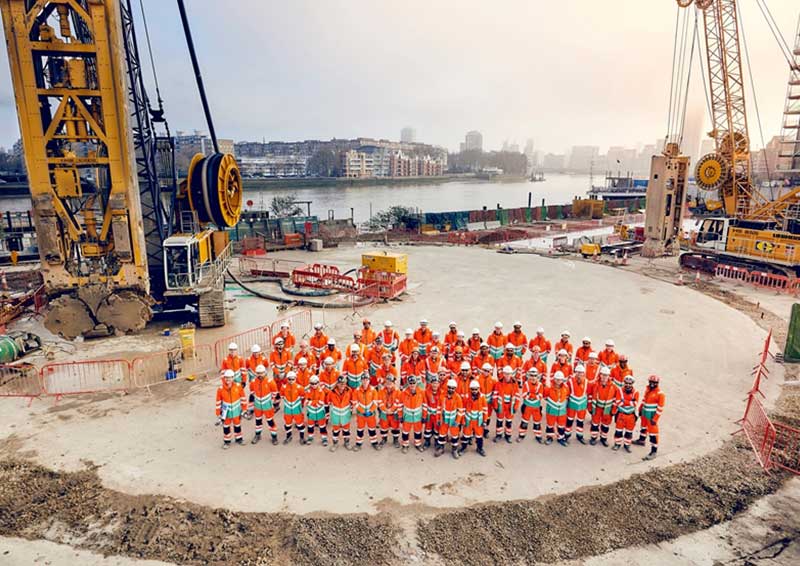Thames Tideway update
See our main article on Thames Tideway here.
Contents |
[edit] Introduction
Tideway, an independent licenced infrastructure provider consisting of a consortium of investors, has been making good progress with construction of London's new 25 km long 'super sewer', the £4.2 billion Thames Tideway tunnel (Stride, 2016).
Ahead of tunnelling in 2018, the main focus of work has been at the three main drive sites. These are for launching the 7.8 m diameter tunnel boring machines (TBMs) and will serve as material transport hubs and head offices for each of Tideway's three main NEC3 works contracts – west, central and east.
[edit] Drive site construction
Chambers Wharf in Bermondsey was one of the first to start, beginning with the removal of thousands of tonnes of contaminated spoil. This was the first opportunity for Tideway to use the river to transport materials, in this case from site to a location outside London for safe disposal.
At Chambers Wharf, the east team has constructed one of the largest new areas of London in over a century, with an infilled cofferdam of 744 piles creating nearly 1 ha of new foreshore. It will form the temporary construction platform for a 25 m diameter, 57 m deep launch shaft for the east TBM, which is due to start tunnelling in 2019.
At Kirtling Street near Battersea power station, Tideway's central team is building the main 33 m diameter double drive shaft, using a hydromill to create 42 shaft wall panels 86 m deep. The next task will be a new jetty to receive the two TBMs later in 2017, as well as for delivery and removal of materials by river.
The third drive site is at Carnwath Road in Fulham, where the west team has undertaken significant river-wall strengthening ahead of secant wall piling to create the launch shaft. Like all Tideway's drive sites, it comprises a number of brownfield land parcel and has required significant clearance and demolition.
[edit] Drop shaft enabling works
At Blackfriars, the central team has recently delivered a new £8 million river-boat pier, lift and stairs to connect river traffic and Blackfriars railway station for the first time. This has enabled removal of the existing Blackfriars pier, which in turn will allow construction of a 24 m diameter, 53 m deep drop shaft to intercept the Fleet Main combined sewer outfall (CSO) – one of 34 being picked up by the new tunnel.
At Victoria Embankment near the Houses of Parliament, the team has also moved the floating bar PS Tattershall Castle 125 m downstream to make room for a 13 m diameter shaft to intercept the Regent Street CSO.
In 2017, there will be noticeable progress on more than a dozen shaft sites across London, including delivery and assembly of TBMS at the west and central drive sites.
The project remains on schedule for completion in 2023, when it will provide a direct 7.2 m diameter link from storm tanks in Acton in the west to Beckton sewage treatment works in the east via the recently completed 6.9 km Lee tunnel.
[edit] Cutting untreated sewage flow
Together with sewage treatment works improvements, the Tideway and Lee tunnels will cut the untreated sewage which flows into the river each year from 39.5 Mt to just 2.4 Mt.
This article was originally published here on 3 Aug 2017 by ICE.
It was written by Andy Alder, Thames Tideway delivery manager, and Mike Appleton, communications executive.
--The Institution of Civil Engineers
[edit] Related articles on Designing Buildings Wiki.
Featured articles and news
The UK’s largest air pollution campaign.
Future Homes Standard, now includes solar, but what else?
Will the new standard, due to in the Autumn, go far enough in terms of performance ?
BSRIA Briefing: Cleaner Air, Better tomorrow
A look back at issues relating to inside and outside air quality, discussed during the BSRIA briefing in 2023.
Restoring Abbotsford's hothouse
Bringing the writer Walter Scott's garden to life.
Reflections on the spending review with CIAT.
Retired firefighter cycles world to raise Grenfell funds
Leaving on 14 June 2025 Stephen will raise money for youth and schools through the Grenfell Foundation.
Key points for construction at a glance with industry reactions.
Functionality, visibility and sustainability
The simpler approach to specification.
Architects, architecture, buildings, and inspiration in film
The close ties between makers and the movies, with our long list of suggested viewing.
SELECT three-point plan for action issued to MSPs
Call for Scottish regulation, green skills and recognition of electrotechnical industry as part of a manifesto for Scottish Parliamentary elections.
UCEM becomes the University of the Built Environment
Major milestone in its 106-year history, follows recent merger with London School of Architecture (LSE).
Professional practical experience for Architects in training
The long process to transform the nature of education and professional practical experience in the Architecture profession following recent reports.
A people-first approach to retrofit
Moving away from the destructive paradigm of fabric-first.
International Electrician Day, 10 June 2025
Celebrating the role of electrical engineers from André-Marie Amperè, today and for the future.
New guide for clients launched at Houses of Parliament
'There has never been a more important time for clients to step up and ...ask the right questions'
The impact of recycled slate tiles
Innovation across the decades.
EPC changes for existing buildings
Changes and their context as the new RdSAP methodology comes into use from 15 June.

























